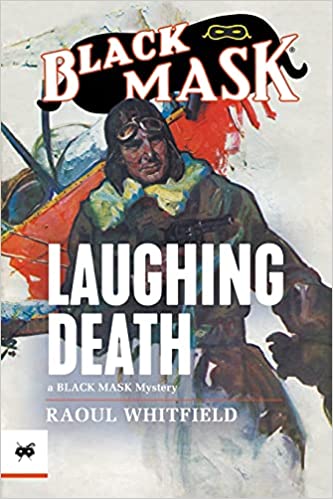“Whisper” Daley has squealed. They got to him at Headquarters. I’m on the spot. Better come home, son.
 When District Attorney Sanford Greer turned out to be too incorruptible and too good at sending mobsters to jail, the Mob decides to place him on the spot–for a storm of lead. Tipped off by an informant, Sanford reaches out to his son for help. Now aviator Gary Greer must race home to reach his father before an assassin’s bullet beat him to the spot.
When District Attorney Sanford Greer turned out to be too incorruptible and too good at sending mobsters to jail, the Mob decides to place him on the spot–for a storm of lead. Tipped off by an informant, Sanford reaches out to his son for help. Now aviator Gary Greer must race home to reach his father before an assassin’s bullet beat him to the spot.
“On the Spot” is the first of a series of short stories by Raoul Whitfield collected in Laughing Death. It is the origin story of Gary Greer and his quest for vengeance. For Greer was too late. And alongside his dead father, Gary finds another dying man. An informant. A mobster with enough respect for the newly departed Sanford Greer to give Gary five names.
Those of the men who killed Sanford Greer.
These men laughed at his father’s death. Now Gary Greer will laugh as he kills each man, one at a time. It’s not a spoiler if it’s on the back cover. And although the destination is certain, sometimes the journey matters more.
Much has been said of the Black Mask style, a style that many confuse for Hemingway’s. A “hard, brittle style” called by Lester Dent as “word savagery.” Many trace this style to Dashiel Hammett. But Raoul Whitfield helped develop the style under the legendary editorship of Joseph T. Shaw. Whitfield proved to be one of the chief stylists for Black Mask. And in “On the Spot”, Whitfield not only brings the classic word savagery, but even works a key phrase–on the spot–into a rhythmic refrain throughout the story. The phrase is death sentence, goad, countdown, and ever-present concern until it becomes an execution, and then, a promise.
This device is used throughout the stories of Laughing Death to pound, like drum tattoo, a core concept. And Whitfield used it a year before Walter Gibson adapted it–for the Shadow! Whitfield also uses numbers throughout the prose to mark time and for rhythmic effect. This is a pulp adventure that deserves to be read aloud for the full effect of rhythm upon mood–and the sense of urgency driving Greer to a single place–on the spot.
But all this style is in service to the emotion of a race against death…and the march towards revenge. And while vengeance may wait for eight more stories to be sated, the visceral appeal of a son avenging his father keeps readers turning the page.
He smiled grimly. There was a way–it came to him, standing in the narrow doorway of the River Street house. There was a way of giving himself a better chance of getting closer to five killers, five names…Tomorrow he would make a beginning. A beginning–for more than one end!
Please give us your valuable comment